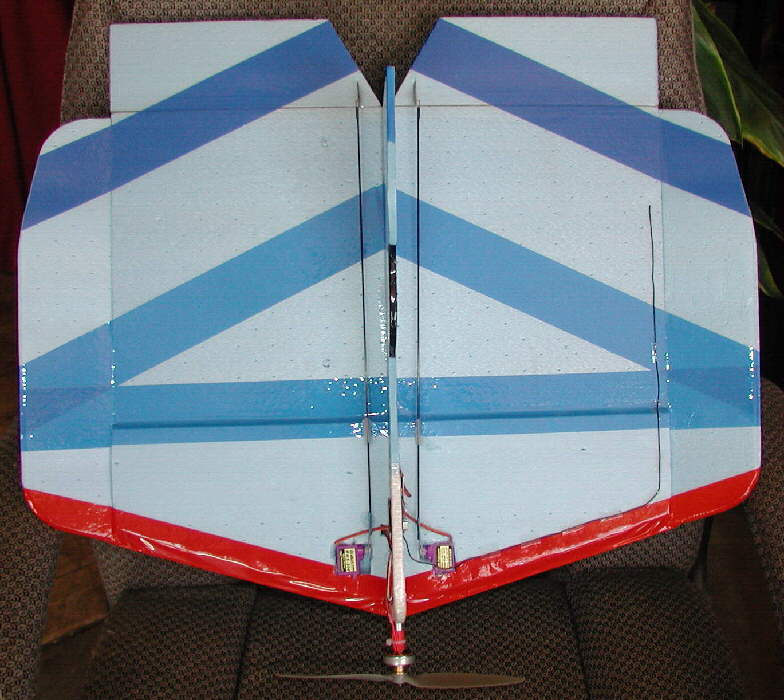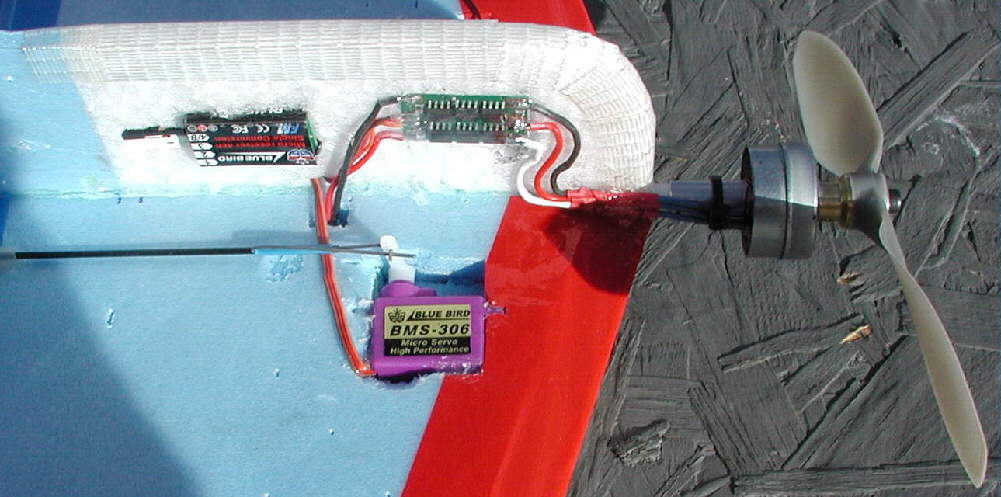

The HOOT is a design originated by Carl Voigt, with a discussion page on RC Groups starting HERE. As with any foamie design, many individuals have implemented a variety of adaptations; photos and details are on the discussion pages. This one which I built is an adaptation of the 'full size' version, with the total wingspan stretched slightly to 23", using wing tip panels 2-7/8" wide, and with a 2-1/2" deep lower EPP fuselage added (which was not included on the original design.). This one is now powered with a slightly largwer / heavier 'double stack stator' CD ROM brushless motor, flying on a 2 cell LiPoly battery pack, at a flying weight of 9-3/8 ounces on a 1000mAH pack. I am now flying it with an 9x6 APC SF prop.
Inspired by discussions, I added an extra layer of BlueCor foam on the top surface from just 1/2" behind the leading edge , extending back to 6-1/4" back from the L.E. at the center. This adds more of an 'airfoil' shape to this flat plate wing, is said to improve the glide substantially, and makes the wing somewhat less pitch-sensitive. I inset a 3/32" x 11-3/4" bamboo skewer spar into the lower surface of this added Bluecor panel before glueing it in place. There is also a 3/32" x 11-3/4" bamboo skewer embedded into the bluecor just 1/4" in fromt of the elevon hinge line. Two more 3/32" bamboo skewers are glued in place along the wing main panel's leading edges.
These photos show my "HOOT" before the first flight; it was about flight-ready when these were taken, minus some velcro for battery pack mounting. While establishing the final balance range, I'll mount the flight battery on the side of the lower fuselage with Velcro; after the desired balance range has been established, I'll make a battery compartment inside the lower fuselage EPP foam to protect the LiPoly battery well on landing. (For cold weathwer flying, this wil also make it possible to keep the battery inside out of the cold air for better flight performance; vented battery compartment covers will be used for warm weather flying.)
I decided to fly this HOOT without the rudder- it can be (and was!) added later.






Winds were running from 6 to 12 MPH during the first flight. Balance was set for this flight at about 4-1/2" back from the center leading edge of the wing- at the forward end of the mentioned balance range. I gave the Hoot a nice level toss into the wind, and it flew out and away beautifully and smoothly. After flying up & around for a bit, I gave it a couple of clicks of up trim; that's all it needed, and it was stable and happy! I kicked in the high rates after the first couple of minutes and started putting her through her more radical paces. The HOOT is quite predictable, and not pitch sensitive. It rolls well, loops fairly tightly - especially on high rates-( and there's even more control surface movement yet available to be set up on the transmitter. :-)
Smoother quiet air will allow exploring the low speed end of the speed envelope more thoroughly; but (with the double stator motor and 9x6 prop) it has enough power and authority to climb out vertically when desired from a slow harrier, and has very good forward speed, and it doesn't mind flying in wind at all. It will fly slowly, hover in a light wind, and can be landed predictably in a very modest amount of space- another fine "Fly Anywhere, Land Anywhere" aircraft!
I'm already wondering what kind of a flat spin it would do with the rudder installed; might be interesting with the raised wing tip panels... but I'll get some more flying time on it before I decide if this one will grow a rudder or not.
02-28-2006 : Flew the HOOT with the APC 9x6 SF prop for the first time; I definitely like the higher pitch speed this prop offers! Even though winds were up, it had good authority. I'll test the 9x7.5 SF prop soon. I also set up the high rates for a faster rool rate, & tighter loops, with positive results; now I'll continue to test shifting the balance point back another 1/16" at a time, to identify the optimum balance point for aerobatics while retaining enoughh stability for high speed flight.

03-10-2006 : ! The rudder has now been added to the HOOT !

I also made the internal battery carrying cutout within the EPP foam; for the remainder of the cool temperature flying season, there are thin plastic hatch covers installed. The one on the right side hinges open to allow the battery and connectors to be enclosed completely inside, out of the snow and cold wind that can otherwise chil the performance of LiPoly batteries. Vented covers will go on for the warmer weather flying season... (at 10,000 feet elevation, that will not be for quite a while yet!) This battery installation deep within the EPP foam also does a superb job of protecting the battery from rough landing sites. The other advantage isa that it cleans up the aiircraft aerodynamicly- nothing is hanging out very far into the airflow on this aircraft.
With the rudder, linkage, and servo added, the HOOT+R is 1/2 ounce heavier, flying at 9-7/8 ounces when using the 1000mAH 2 cell LiPoly pack. When my 1300 mAH 2 cell LiPoly battery is installed inside, as shown in the last photo above, the weight is increased to around 10-1/4 ounces.
It's snowing, with around 8" of fresh snow on the ground and more coming down steadily, so flying the HOOT+R to try out the new aerobatic capabilities with the newly added rudder may have to wait for more suitable landing conditions- no point in getting moisture into the servos & receiver! (Once the snow stops & the roads have been plowed, I'll be able to land it on the road... I just have to be a bit patient until then.) I'll add a flight report when I've had a chance to try the +R setup.
More later!!
So how does it respond to having a rudder? Very nicely!!! It was snowing earlier today; but I took it down to get a few minutes of flying in later in the day (even though the snow was still lightly falling, & the temperature was only around 14 degrees F.)
With the rudder added, flat spins are very easy to do. It enters them easily, stays in the spin well, and exits quickly & predictably when you re-center the sticks (or simply fly out of it into another maneuver.) High alpha attitudes are more managable now, and low speed landings are easy and predictable.
While you can get irreverent flying in the wind with this design, I have my most fun flying my HOOT in calm air with a 10x3.8 APC prop... airplanes were never supposed to be able to do this kind of stuff back when I started building RC!!!
My HOOT is one of the planes that almost always goes along these days, and it never fails to produce smiles and amazment by everyone who sees it in the air.